Holmes Institute HI5017 Managerial Accounting Report: Analysis
VerifiedAdded on 2022/12/29
|12
|4576
|93
Report
AI Summary
This report focuses on managerial accounting techniques, including Activity-Based Costing (ABC), Balanced Scorecard, and Value Chain analysis, within a case study context. It explores how these systems support managerial decision-making in contemporary businesses. The report analyzes the relevance of these techniques by contrasting findings from case studies with academic journal articles. It investigates the application of these systems in real-world scenarios, considering the implications of uncertain business environments. Furthermore, the report identifies learning outcomes derived from the research and provides insights useful for management accountants. The report examines contemporary management accounting techniques, implementation challenges, and the impact of these systems on organizational performance and financial outcomes. The report also discusses the importance of inventory management and strategic change within the context of management accounting.
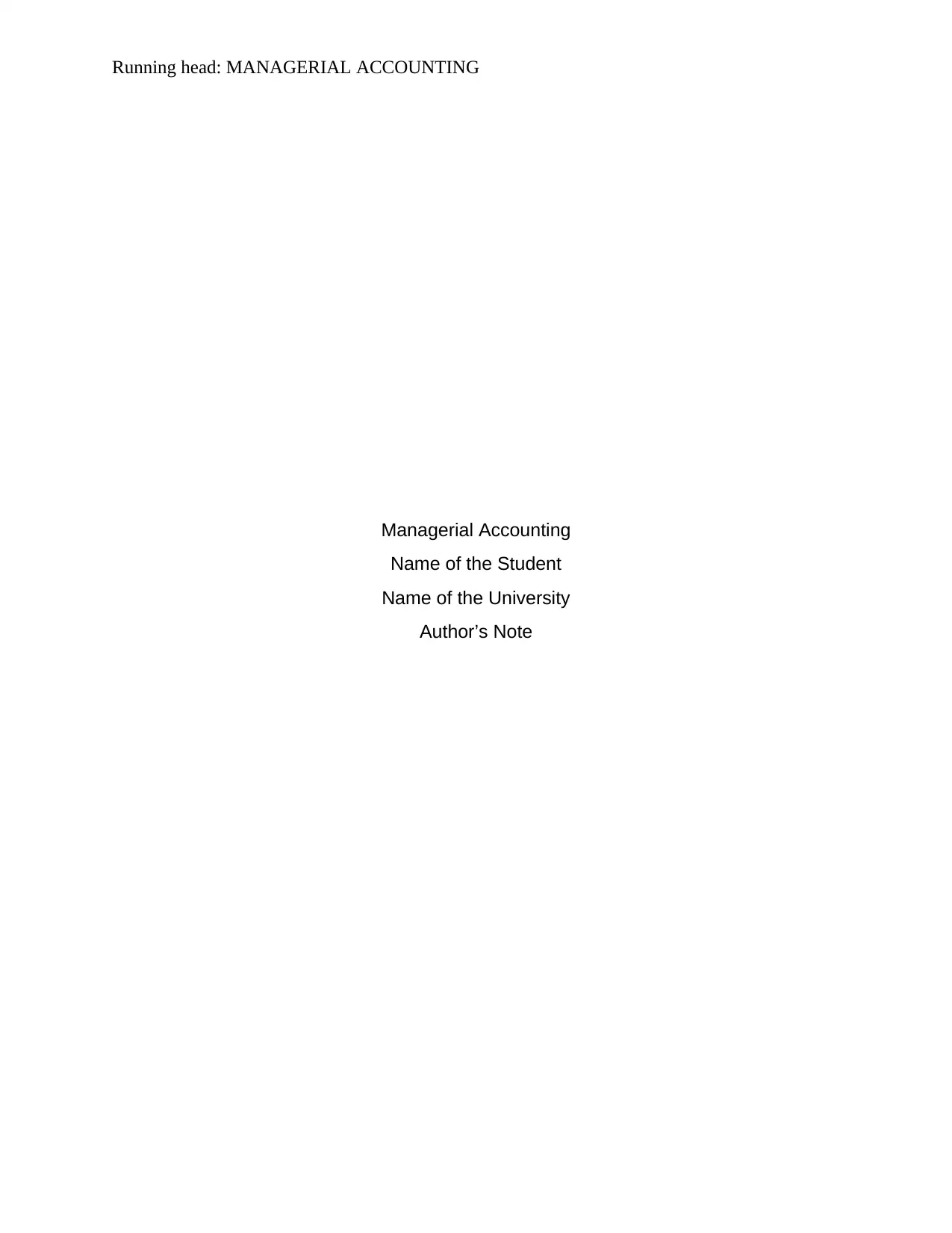
Running head: MANAGERIAL ACCOUNTING
Managerial Accounting
Name of the Student
Name of the University
Author’s Note
Managerial Accounting
Name of the Student
Name of the University
Author’s Note
Paraphrase This Document
Need a fresh take? Get an instant paraphrase of this document with our AI Paraphraser
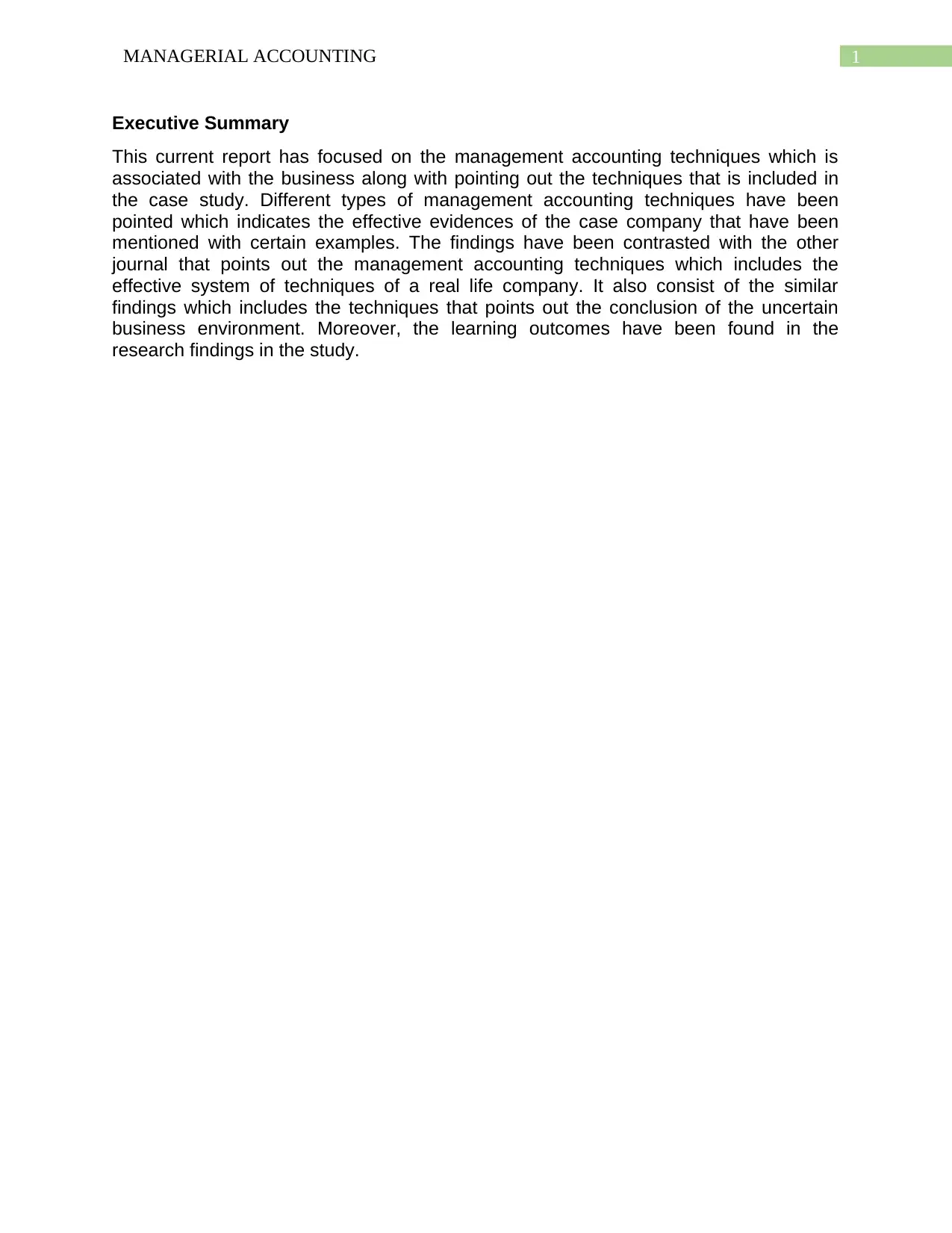
1MANAGERIAL ACCOUNTING
Executive Summary
This current report has focused on the management accounting techniques which is
associated with the business along with pointing out the techniques that is included in
the case study. Different types of management accounting techniques have been
pointed which indicates the effective evidences of the case company that have been
mentioned with certain examples. The findings have been contrasted with the other
journal that points out the management accounting techniques which includes the
effective system of techniques of a real life company. It also consist of the similar
findings which includes the techniques that points out the conclusion of the uncertain
business environment. Moreover, the learning outcomes have been found in the
research findings in the study.
Executive Summary
This current report has focused on the management accounting techniques which is
associated with the business along with pointing out the techniques that is included in
the case study. Different types of management accounting techniques have been
pointed which indicates the effective evidences of the case company that have been
mentioned with certain examples. The findings have been contrasted with the other
journal that points out the management accounting techniques which includes the
effective system of techniques of a real life company. It also consist of the similar
findings which includes the techniques that points out the conclusion of the uncertain
business environment. Moreover, the learning outcomes have been found in the
research findings in the study.
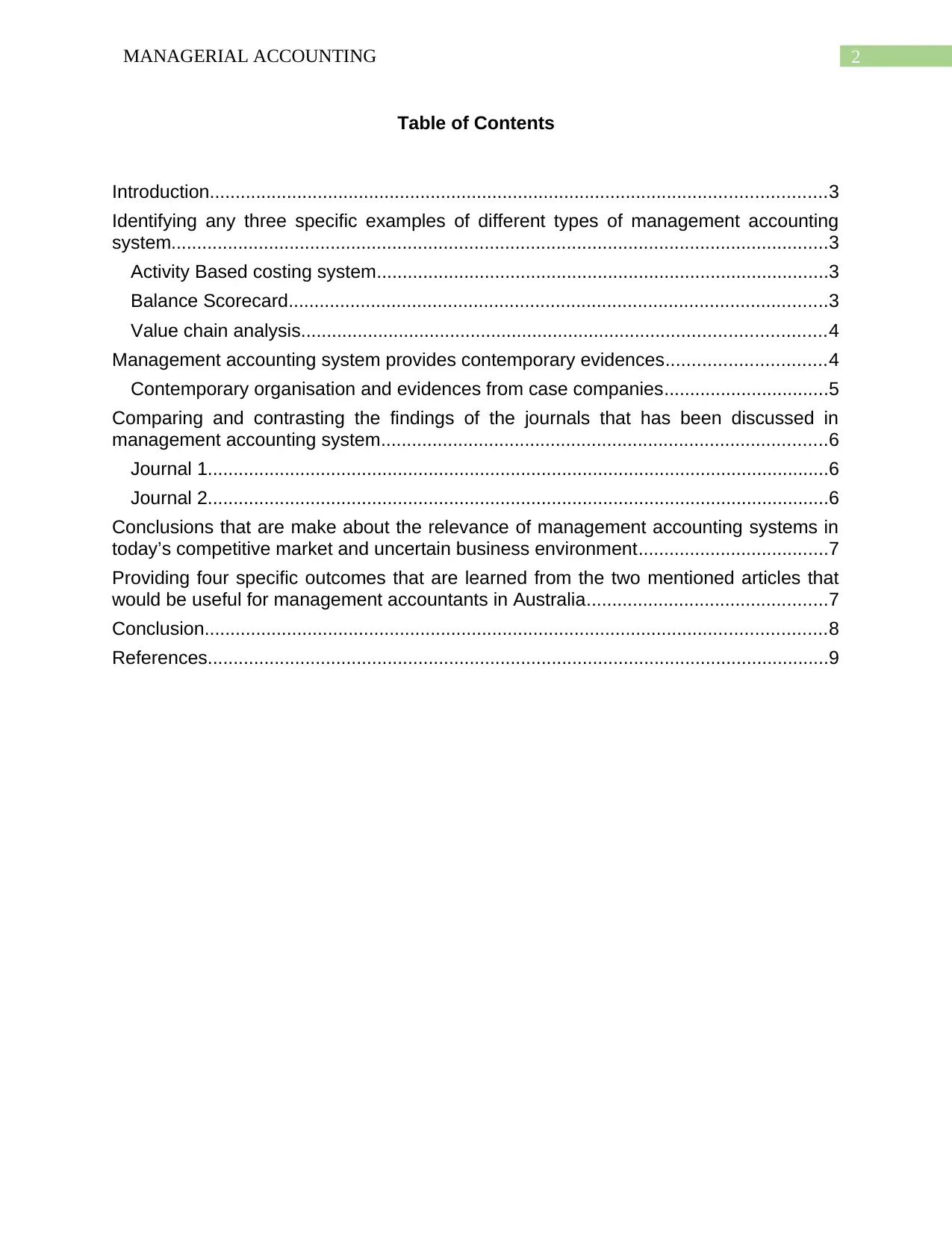
2MANAGERIAL ACCOUNTING
Table of Contents
Introduction........................................................................................................................3
Identifying any three specific examples of different types of management accounting
system................................................................................................................................3
Activity Based costing system........................................................................................3
Balance Scorecard.........................................................................................................3
Value chain analysis......................................................................................................4
Management accounting system provides contemporary evidences...............................4
Contemporary organisation and evidences from case companies................................5
Comparing and contrasting the findings of the journals that has been discussed in
management accounting system.......................................................................................6
Journal 1.........................................................................................................................6
Journal 2.........................................................................................................................6
Conclusions that are make about the relevance of management accounting systems in
today’s competitive market and uncertain business environment.....................................7
Providing four specific outcomes that are learned from the two mentioned articles that
would be useful for management accountants in Australia...............................................7
Conclusion.........................................................................................................................8
References.........................................................................................................................9
Table of Contents
Introduction........................................................................................................................3
Identifying any three specific examples of different types of management accounting
system................................................................................................................................3
Activity Based costing system........................................................................................3
Balance Scorecard.........................................................................................................3
Value chain analysis......................................................................................................4
Management accounting system provides contemporary evidences...............................4
Contemporary organisation and evidences from case companies................................5
Comparing and contrasting the findings of the journals that has been discussed in
management accounting system.......................................................................................6
Journal 1.........................................................................................................................6
Journal 2.........................................................................................................................6
Conclusions that are make about the relevance of management accounting systems in
today’s competitive market and uncertain business environment.....................................7
Providing four specific outcomes that are learned from the two mentioned articles that
would be useful for management accountants in Australia...............................................7
Conclusion.........................................................................................................................8
References.........................................................................................................................9
⊘ This is a preview!⊘
Do you want full access?
Subscribe today to unlock all pages.

Trusted by 1+ million students worldwide
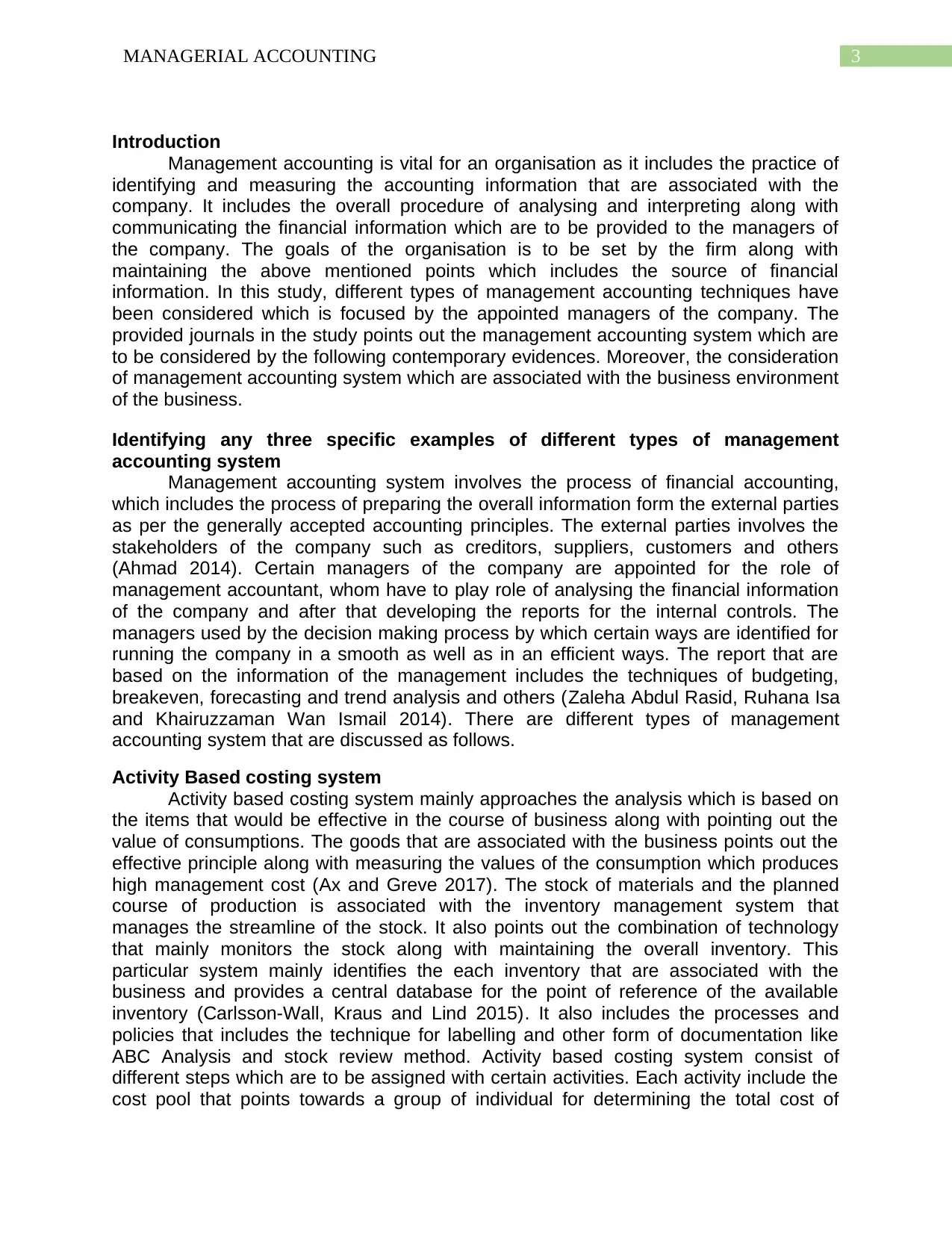
3MANAGERIAL ACCOUNTING
Introduction
Management accounting is vital for an organisation as it includes the practice of
identifying and measuring the accounting information that are associated with the
company. It includes the overall procedure of analysing and interpreting along with
communicating the financial information which are to be provided to the managers of
the company. The goals of the organisation is to be set by the firm along with
maintaining the above mentioned points which includes the source of financial
information. In this study, different types of management accounting techniques have
been considered which is focused by the appointed managers of the company. The
provided journals in the study points out the management accounting system which are
to be considered by the following contemporary evidences. Moreover, the consideration
of management accounting system which are associated with the business environment
of the business.
Identifying any three specific examples of different types of management
accounting system
Management accounting system involves the process of financial accounting,
which includes the process of preparing the overall information form the external parties
as per the generally accepted accounting principles. The external parties involves the
stakeholders of the company such as creditors, suppliers, customers and others
(Ahmad 2014). Certain managers of the company are appointed for the role of
management accountant, whom have to play role of analysing the financial information
of the company and after that developing the reports for the internal controls. The
managers used by the decision making process by which certain ways are identified for
running the company in a smooth as well as in an efficient ways. The report that are
based on the information of the management includes the techniques of budgeting,
breakeven, forecasting and trend analysis and others (Zaleha Abdul Rasid, Ruhana Isa
and Khairuzzaman Wan Ismail 2014). There are different types of management
accounting system that are discussed as follows.
Activity Based costing system
Activity based costing system mainly approaches the analysis which is based on
the items that would be effective in the course of business along with pointing out the
value of consumptions. The goods that are associated with the business points out the
effective principle along with measuring the values of the consumption which produces
high management cost (Ax and Greve 2017). The stock of materials and the planned
course of production is associated with the inventory management system that
manages the streamline of the stock. It also points out the combination of technology
that mainly monitors the stock along with maintaining the overall inventory. This
particular system mainly identifies the each inventory that are associated with the
business and provides a central database for the point of reference of the available
inventory (Carlsson-Wall, Kraus and Lind 2015). It also includes the processes and
policies that includes the technique for labelling and other form of documentation like
ABC Analysis and stock review method. Activity based costing system consist of
different steps which are to be assigned with certain activities. Each activity include the
cost pool that points towards a group of individual for determining the total cost of
Introduction
Management accounting is vital for an organisation as it includes the practice of
identifying and measuring the accounting information that are associated with the
company. It includes the overall procedure of analysing and interpreting along with
communicating the financial information which are to be provided to the managers of
the company. The goals of the organisation is to be set by the firm along with
maintaining the above mentioned points which includes the source of financial
information. In this study, different types of management accounting techniques have
been considered which is focused by the appointed managers of the company. The
provided journals in the study points out the management accounting system which are
to be considered by the following contemporary evidences. Moreover, the consideration
of management accounting system which are associated with the business environment
of the business.
Identifying any three specific examples of different types of management
accounting system
Management accounting system involves the process of financial accounting,
which includes the process of preparing the overall information form the external parties
as per the generally accepted accounting principles. The external parties involves the
stakeholders of the company such as creditors, suppliers, customers and others
(Ahmad 2014). Certain managers of the company are appointed for the role of
management accountant, whom have to play role of analysing the financial information
of the company and after that developing the reports for the internal controls. The
managers used by the decision making process by which certain ways are identified for
running the company in a smooth as well as in an efficient ways. The report that are
based on the information of the management includes the techniques of budgeting,
breakeven, forecasting and trend analysis and others (Zaleha Abdul Rasid, Ruhana Isa
and Khairuzzaman Wan Ismail 2014). There are different types of management
accounting system that are discussed as follows.
Activity Based costing system
Activity based costing system mainly approaches the analysis which is based on
the items that would be effective in the course of business along with pointing out the
value of consumptions. The goods that are associated with the business points out the
effective principle along with measuring the values of the consumption which produces
high management cost (Ax and Greve 2017). The stock of materials and the planned
course of production is associated with the inventory management system that
manages the streamline of the stock. It also points out the combination of technology
that mainly monitors the stock along with maintaining the overall inventory. This
particular system mainly identifies the each inventory that are associated with the
business and provides a central database for the point of reference of the available
inventory (Carlsson-Wall, Kraus and Lind 2015). It also includes the processes and
policies that includes the technique for labelling and other form of documentation like
ABC Analysis and stock review method. Activity based costing system consist of
different steps which are to be assigned with certain activities. Each activity include the
cost pool that points towards a group of individual for determining the total cost of
Paraphrase This Document
Need a fresh take? Get an instant paraphrase of this document with our AI Paraphraser
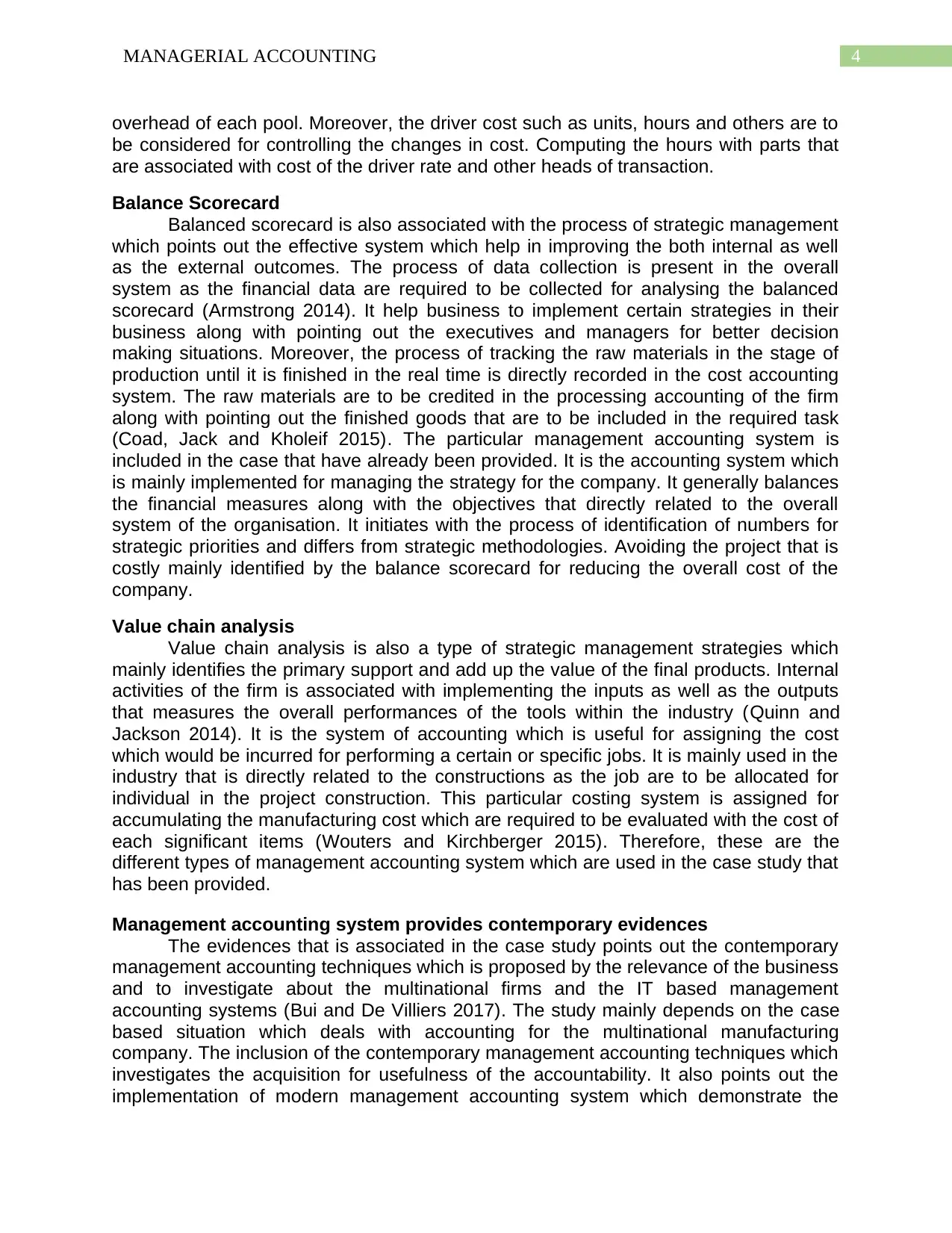
4MANAGERIAL ACCOUNTING
overhead of each pool. Moreover, the driver cost such as units, hours and others are to
be considered for controlling the changes in cost. Computing the hours with parts that
are associated with cost of the driver rate and other heads of transaction.
Balance Scorecard
Balanced scorecard is also associated with the process of strategic management
which points out the effective system which help in improving the both internal as well
as the external outcomes. The process of data collection is present in the overall
system as the financial data are required to be collected for analysing the balanced
scorecard (Armstrong 2014). It help business to implement certain strategies in their
business along with pointing out the executives and managers for better decision
making situations. Moreover, the process of tracking the raw materials in the stage of
production until it is finished in the real time is directly recorded in the cost accounting
system. The raw materials are to be credited in the processing accounting of the firm
along with pointing out the finished goods that are to be included in the required task
(Coad, Jack and Kholeif 2015). The particular management accounting system is
included in the case that have already been provided. It is the accounting system which
is mainly implemented for managing the strategy for the company. It generally balances
the financial measures along with the objectives that directly related to the overall
system of the organisation. It initiates with the process of identification of numbers for
strategic priorities and differs from strategic methodologies. Avoiding the project that is
costly mainly identified by the balance scorecard for reducing the overall cost of the
company.
Value chain analysis
Value chain analysis is also a type of strategic management strategies which
mainly identifies the primary support and add up the value of the final products. Internal
activities of the firm is associated with implementing the inputs as well as the outputs
that measures the overall performances of the tools within the industry (Quinn and
Jackson 2014). It is the system of accounting which is useful for assigning the cost
which would be incurred for performing a certain or specific jobs. It is mainly used in the
industry that is directly related to the constructions as the job are to be allocated for
individual in the project construction. This particular costing system is assigned for
accumulating the manufacturing cost which are required to be evaluated with the cost of
each significant items (Wouters and Kirchberger 2015). Therefore, these are the
different types of management accounting system which are used in the case study that
has been provided.
Management accounting system provides contemporary evidences
The evidences that is associated in the case study points out the contemporary
management accounting techniques which is proposed by the relevance of the business
and to investigate about the multinational firms and the IT based management
accounting systems (Bui and De Villiers 2017). The study mainly depends on the case
based situation which deals with accounting for the multinational manufacturing
company. The inclusion of the contemporary management accounting techniques which
investigates the acquisition for usefulness of the accountability. It also points out the
implementation of modern management accounting system which demonstrate the
overhead of each pool. Moreover, the driver cost such as units, hours and others are to
be considered for controlling the changes in cost. Computing the hours with parts that
are associated with cost of the driver rate and other heads of transaction.
Balance Scorecard
Balanced scorecard is also associated with the process of strategic management
which points out the effective system which help in improving the both internal as well
as the external outcomes. The process of data collection is present in the overall
system as the financial data are required to be collected for analysing the balanced
scorecard (Armstrong 2014). It help business to implement certain strategies in their
business along with pointing out the executives and managers for better decision
making situations. Moreover, the process of tracking the raw materials in the stage of
production until it is finished in the real time is directly recorded in the cost accounting
system. The raw materials are to be credited in the processing accounting of the firm
along with pointing out the finished goods that are to be included in the required task
(Coad, Jack and Kholeif 2015). The particular management accounting system is
included in the case that have already been provided. It is the accounting system which
is mainly implemented for managing the strategy for the company. It generally balances
the financial measures along with the objectives that directly related to the overall
system of the organisation. It initiates with the process of identification of numbers for
strategic priorities and differs from strategic methodologies. Avoiding the project that is
costly mainly identified by the balance scorecard for reducing the overall cost of the
company.
Value chain analysis
Value chain analysis is also a type of strategic management strategies which
mainly identifies the primary support and add up the value of the final products. Internal
activities of the firm is associated with implementing the inputs as well as the outputs
that measures the overall performances of the tools within the industry (Quinn and
Jackson 2014). It is the system of accounting which is useful for assigning the cost
which would be incurred for performing a certain or specific jobs. It is mainly used in the
industry that is directly related to the constructions as the job are to be allocated for
individual in the project construction. This particular costing system is assigned for
accumulating the manufacturing cost which are required to be evaluated with the cost of
each significant items (Wouters and Kirchberger 2015). Therefore, these are the
different types of management accounting system which are used in the case study that
has been provided.
Management accounting system provides contemporary evidences
The evidences that is associated in the case study points out the contemporary
management accounting techniques which is proposed by the relevance of the business
and to investigate about the multinational firms and the IT based management
accounting systems (Bui and De Villiers 2017). The study mainly depends on the case
based situation which deals with accounting for the multinational manufacturing
company. The inclusion of the contemporary management accounting techniques which
investigates the acquisition for usefulness of the accountability. It also points out the
implementation of modern management accounting system which demonstrate the
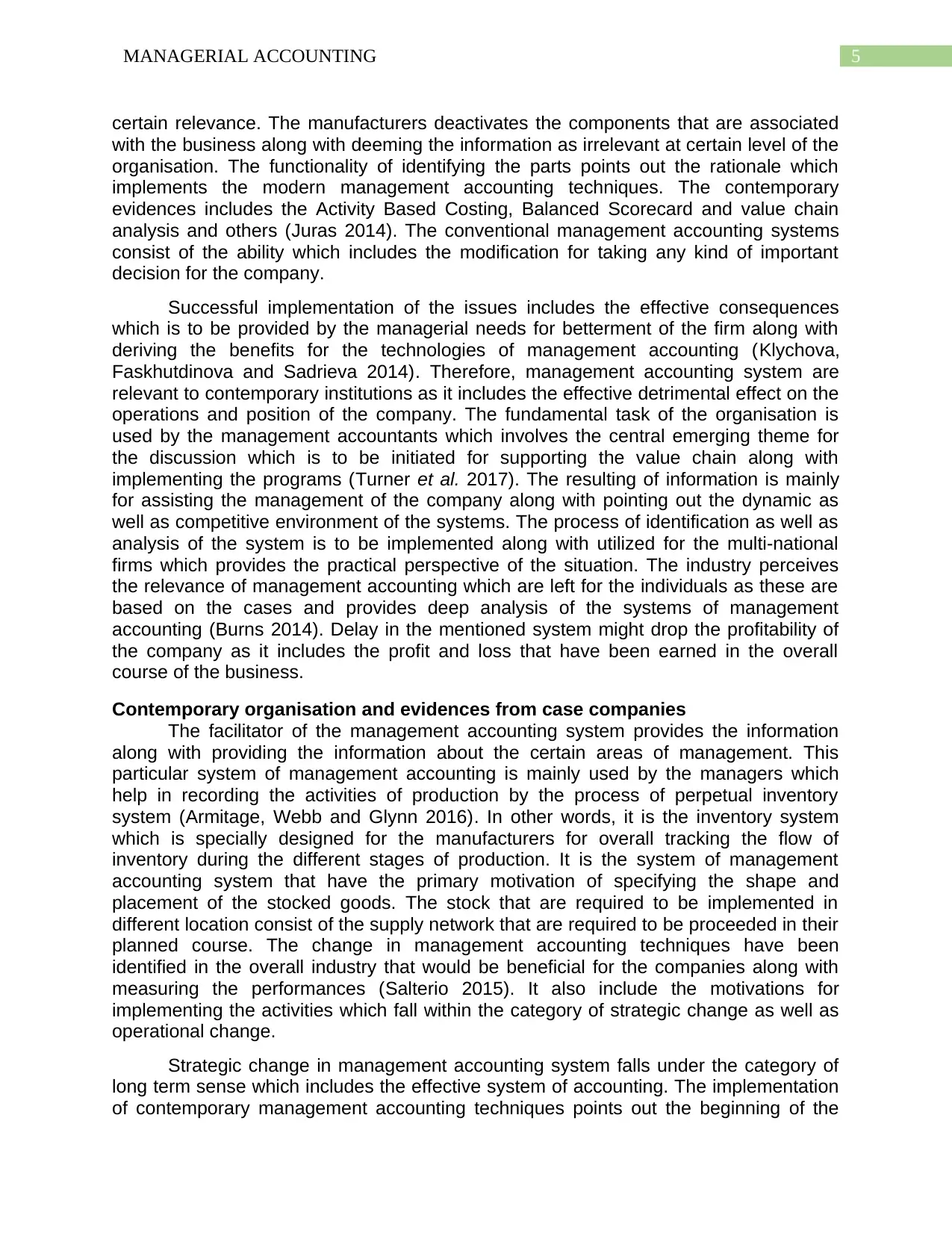
5MANAGERIAL ACCOUNTING
certain relevance. The manufacturers deactivates the components that are associated
with the business along with deeming the information as irrelevant at certain level of the
organisation. The functionality of identifying the parts points out the rationale which
implements the modern management accounting techniques. The contemporary
evidences includes the Activity Based Costing, Balanced Scorecard and value chain
analysis and others (Juras 2014). The conventional management accounting systems
consist of the ability which includes the modification for taking any kind of important
decision for the company.
Successful implementation of the issues includes the effective consequences
which is to be provided by the managerial needs for betterment of the firm along with
deriving the benefits for the technologies of management accounting (Klychova,
Faskhutdinova and Sadrieva 2014). Therefore, management accounting system are
relevant to contemporary institutions as it includes the effective detrimental effect on the
operations and position of the company. The fundamental task of the organisation is
used by the management accountants which involves the central emerging theme for
the discussion which is to be initiated for supporting the value chain along with
implementing the programs (Turner et al. 2017). The resulting of information is mainly
for assisting the management of the company along with pointing out the dynamic as
well as competitive environment of the systems. The process of identification as well as
analysis of the system is to be implemented along with utilized for the multi-national
firms which provides the practical perspective of the situation. The industry perceives
the relevance of management accounting which are left for the individuals as these are
based on the cases and provides deep analysis of the systems of management
accounting (Burns 2014). Delay in the mentioned system might drop the profitability of
the company as it includes the profit and loss that have been earned in the overall
course of the business.
Contemporary organisation and evidences from case companies
The facilitator of the management accounting system provides the information
along with providing the information about the certain areas of management. This
particular system of management accounting is mainly used by the managers which
help in recording the activities of production by the process of perpetual inventory
system (Armitage, Webb and Glynn 2016). In other words, it is the inventory system
which is specially designed for the manufacturers for overall tracking the flow of
inventory during the different stages of production. It is the system of management
accounting system that have the primary motivation of specifying the shape and
placement of the stocked goods. The stock that are required to be implemented in
different location consist of the supply network that are required to be proceeded in their
planned course. The change in management accounting techniques have been
identified in the overall industry that would be beneficial for the companies along with
measuring the performances (Salterio 2015). It also include the motivations for
implementing the activities which fall within the category of strategic change as well as
operational change.
Strategic change in management accounting system falls under the category of
long term sense which includes the effective system of accounting. The implementation
of contemporary management accounting techniques points out the beginning of the
certain relevance. The manufacturers deactivates the components that are associated
with the business along with deeming the information as irrelevant at certain level of the
organisation. The functionality of identifying the parts points out the rationale which
implements the modern management accounting techniques. The contemporary
evidences includes the Activity Based Costing, Balanced Scorecard and value chain
analysis and others (Juras 2014). The conventional management accounting systems
consist of the ability which includes the modification for taking any kind of important
decision for the company.
Successful implementation of the issues includes the effective consequences
which is to be provided by the managerial needs for betterment of the firm along with
deriving the benefits for the technologies of management accounting (Klychova,
Faskhutdinova and Sadrieva 2014). Therefore, management accounting system are
relevant to contemporary institutions as it includes the effective detrimental effect on the
operations and position of the company. The fundamental task of the organisation is
used by the management accountants which involves the central emerging theme for
the discussion which is to be initiated for supporting the value chain along with
implementing the programs (Turner et al. 2017). The resulting of information is mainly
for assisting the management of the company along with pointing out the dynamic as
well as competitive environment of the systems. The process of identification as well as
analysis of the system is to be implemented along with utilized for the multi-national
firms which provides the practical perspective of the situation. The industry perceives
the relevance of management accounting which are left for the individuals as these are
based on the cases and provides deep analysis of the systems of management
accounting (Burns 2014). Delay in the mentioned system might drop the profitability of
the company as it includes the profit and loss that have been earned in the overall
course of the business.
Contemporary organisation and evidences from case companies
The facilitator of the management accounting system provides the information
along with providing the information about the certain areas of management. This
particular system of management accounting is mainly used by the managers which
help in recording the activities of production by the process of perpetual inventory
system (Armitage, Webb and Glynn 2016). In other words, it is the inventory system
which is specially designed for the manufacturers for overall tracking the flow of
inventory during the different stages of production. It is the system of management
accounting system that have the primary motivation of specifying the shape and
placement of the stocked goods. The stock that are required to be implemented in
different location consist of the supply network that are required to be proceeded in their
planned course. The change in management accounting techniques have been
identified in the overall industry that would be beneficial for the companies along with
measuring the performances (Salterio 2015). It also include the motivations for
implementing the activities which fall within the category of strategic change as well as
operational change.
Strategic change in management accounting system falls under the category of
long term sense which includes the effective system of accounting. The implementation
of contemporary management accounting techniques points out the beginning of the
⊘ This is a preview!⊘
Do you want full access?
Subscribe today to unlock all pages.

Trusted by 1+ million students worldwide
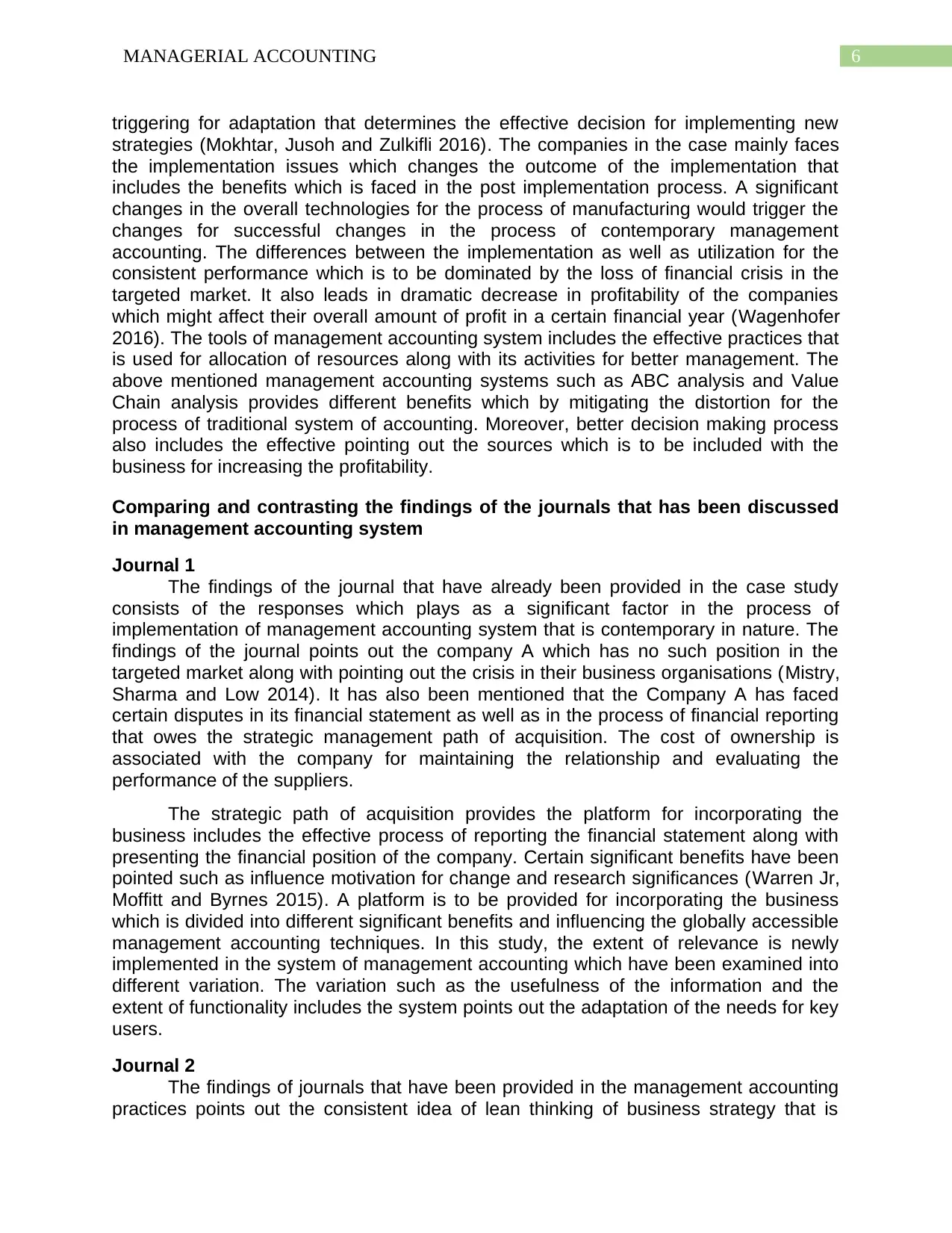
6MANAGERIAL ACCOUNTING
triggering for adaptation that determines the effective decision for implementing new
strategies (Mokhtar, Jusoh and Zulkifli 2016). The companies in the case mainly faces
the implementation issues which changes the outcome of the implementation that
includes the benefits which is faced in the post implementation process. A significant
changes in the overall technologies for the process of manufacturing would trigger the
changes for successful changes in the process of contemporary management
accounting. The differences between the implementation as well as utilization for the
consistent performance which is to be dominated by the loss of financial crisis in the
targeted market. It also leads in dramatic decrease in profitability of the companies
which might affect their overall amount of profit in a certain financial year (Wagenhofer
2016). The tools of management accounting system includes the effective practices that
is used for allocation of resources along with its activities for better management. The
above mentioned management accounting systems such as ABC analysis and Value
Chain analysis provides different benefits which by mitigating the distortion for the
process of traditional system of accounting. Moreover, better decision making process
also includes the effective pointing out the sources which is to be included with the
business for increasing the profitability.
Comparing and contrasting the findings of the journals that has been discussed
in management accounting system
Journal 1
The findings of the journal that have already been provided in the case study
consists of the responses which plays as a significant factor in the process of
implementation of management accounting system that is contemporary in nature. The
findings of the journal points out the company A which has no such position in the
targeted market along with pointing out the crisis in their business organisations (Mistry,
Sharma and Low 2014). It has also been mentioned that the Company A has faced
certain disputes in its financial statement as well as in the process of financial reporting
that owes the strategic management path of acquisition. The cost of ownership is
associated with the company for maintaining the relationship and evaluating the
performance of the suppliers.
The strategic path of acquisition provides the platform for incorporating the
business includes the effective process of reporting the financial statement along with
presenting the financial position of the company. Certain significant benefits have been
pointed such as influence motivation for change and research significances (Warren Jr,
Moffitt and Byrnes 2015). A platform is to be provided for incorporating the business
which is divided into different significant benefits and influencing the globally accessible
management accounting techniques. In this study, the extent of relevance is newly
implemented in the system of management accounting which have been examined into
different variation. The variation such as the usefulness of the information and the
extent of functionality includes the system points out the adaptation of the needs for key
users.
Journal 2
The findings of journals that have been provided in the management accounting
practices points out the consistent idea of lean thinking of business strategy that is
triggering for adaptation that determines the effective decision for implementing new
strategies (Mokhtar, Jusoh and Zulkifli 2016). The companies in the case mainly faces
the implementation issues which changes the outcome of the implementation that
includes the benefits which is faced in the post implementation process. A significant
changes in the overall technologies for the process of manufacturing would trigger the
changes for successful changes in the process of contemporary management
accounting. The differences between the implementation as well as utilization for the
consistent performance which is to be dominated by the loss of financial crisis in the
targeted market. It also leads in dramatic decrease in profitability of the companies
which might affect their overall amount of profit in a certain financial year (Wagenhofer
2016). The tools of management accounting system includes the effective practices that
is used for allocation of resources along with its activities for better management. The
above mentioned management accounting systems such as ABC analysis and Value
Chain analysis provides different benefits which by mitigating the distortion for the
process of traditional system of accounting. Moreover, better decision making process
also includes the effective pointing out the sources which is to be included with the
business for increasing the profitability.
Comparing and contrasting the findings of the journals that has been discussed
in management accounting system
Journal 1
The findings of the journal that have already been provided in the case study
consists of the responses which plays as a significant factor in the process of
implementation of management accounting system that is contemporary in nature. The
findings of the journal points out the company A which has no such position in the
targeted market along with pointing out the crisis in their business organisations (Mistry,
Sharma and Low 2014). It has also been mentioned that the Company A has faced
certain disputes in its financial statement as well as in the process of financial reporting
that owes the strategic management path of acquisition. The cost of ownership is
associated with the company for maintaining the relationship and evaluating the
performance of the suppliers.
The strategic path of acquisition provides the platform for incorporating the
business includes the effective process of reporting the financial statement along with
presenting the financial position of the company. Certain significant benefits have been
pointed such as influence motivation for change and research significances (Warren Jr,
Moffitt and Byrnes 2015). A platform is to be provided for incorporating the business
which is divided into different significant benefits and influencing the globally accessible
management accounting techniques. In this study, the extent of relevance is newly
implemented in the system of management accounting which have been examined into
different variation. The variation such as the usefulness of the information and the
extent of functionality includes the system points out the adaptation of the needs for key
users.
Journal 2
The findings of journals that have been provided in the management accounting
practices points out the consistent idea of lean thinking of business strategy that is
Paraphrase This Document
Need a fresh take? Get an instant paraphrase of this document with our AI Paraphraser
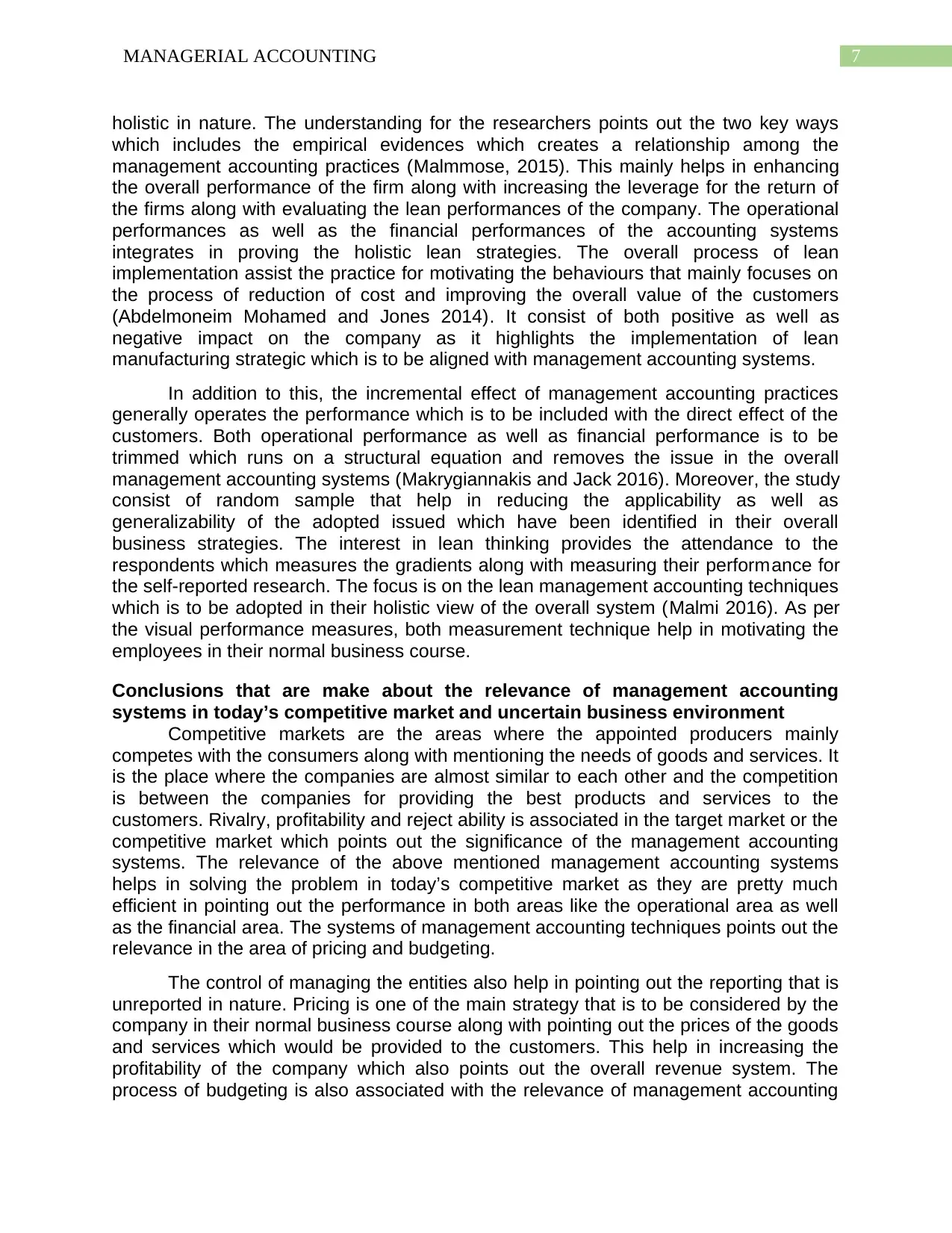
7MANAGERIAL ACCOUNTING
holistic in nature. The understanding for the researchers points out the two key ways
which includes the empirical evidences which creates a relationship among the
management accounting practices (Malmmose, 2015). This mainly helps in enhancing
the overall performance of the firm along with increasing the leverage for the return of
the firms along with evaluating the lean performances of the company. The operational
performances as well as the financial performances of the accounting systems
integrates in proving the holistic lean strategies. The overall process of lean
implementation assist the practice for motivating the behaviours that mainly focuses on
the process of reduction of cost and improving the overall value of the customers
(Abdelmoneim Mohamed and Jones 2014). It consist of both positive as well as
negative impact on the company as it highlights the implementation of lean
manufacturing strategic which is to be aligned with management accounting systems.
In addition to this, the incremental effect of management accounting practices
generally operates the performance which is to be included with the direct effect of the
customers. Both operational performance as well as financial performance is to be
trimmed which runs on a structural equation and removes the issue in the overall
management accounting systems (Makrygiannakis and Jack 2016). Moreover, the study
consist of random sample that help in reducing the applicability as well as
generalizability of the adopted issued which have been identified in their overall
business strategies. The interest in lean thinking provides the attendance to the
respondents which measures the gradients along with measuring their performance for
the self-reported research. The focus is on the lean management accounting techniques
which is to be adopted in their holistic view of the overall system (Malmi 2016). As per
the visual performance measures, both measurement technique help in motivating the
employees in their normal business course.
Conclusions that are make about the relevance of management accounting
systems in today’s competitive market and uncertain business environment
Competitive markets are the areas where the appointed producers mainly
competes with the consumers along with mentioning the needs of goods and services. It
is the place where the companies are almost similar to each other and the competition
is between the companies for providing the best products and services to the
customers. Rivalry, profitability and reject ability is associated in the target market or the
competitive market which points out the significance of the management accounting
systems. The relevance of the above mentioned management accounting systems
helps in solving the problem in today’s competitive market as they are pretty much
efficient in pointing out the performance in both areas like the operational area as well
as the financial area. The systems of management accounting techniques points out the
relevance in the area of pricing and budgeting.
The control of managing the entities also help in pointing out the reporting that is
unreported in nature. Pricing is one of the main strategy that is to be considered by the
company in their normal business course along with pointing out the prices of the goods
and services which would be provided to the customers. This help in increasing the
profitability of the company which also points out the overall revenue system. The
process of budgeting is also associated with the relevance of management accounting
holistic in nature. The understanding for the researchers points out the two key ways
which includes the empirical evidences which creates a relationship among the
management accounting practices (Malmmose, 2015). This mainly helps in enhancing
the overall performance of the firm along with increasing the leverage for the return of
the firms along with evaluating the lean performances of the company. The operational
performances as well as the financial performances of the accounting systems
integrates in proving the holistic lean strategies. The overall process of lean
implementation assist the practice for motivating the behaviours that mainly focuses on
the process of reduction of cost and improving the overall value of the customers
(Abdelmoneim Mohamed and Jones 2014). It consist of both positive as well as
negative impact on the company as it highlights the implementation of lean
manufacturing strategic which is to be aligned with management accounting systems.
In addition to this, the incremental effect of management accounting practices
generally operates the performance which is to be included with the direct effect of the
customers. Both operational performance as well as financial performance is to be
trimmed which runs on a structural equation and removes the issue in the overall
management accounting systems (Makrygiannakis and Jack 2016). Moreover, the study
consist of random sample that help in reducing the applicability as well as
generalizability of the adopted issued which have been identified in their overall
business strategies. The interest in lean thinking provides the attendance to the
respondents which measures the gradients along with measuring their performance for
the self-reported research. The focus is on the lean management accounting techniques
which is to be adopted in their holistic view of the overall system (Malmi 2016). As per
the visual performance measures, both measurement technique help in motivating the
employees in their normal business course.
Conclusions that are make about the relevance of management accounting
systems in today’s competitive market and uncertain business environment
Competitive markets are the areas where the appointed producers mainly
competes with the consumers along with mentioning the needs of goods and services. It
is the place where the companies are almost similar to each other and the competition
is between the companies for providing the best products and services to the
customers. Rivalry, profitability and reject ability is associated in the target market or the
competitive market which points out the significance of the management accounting
systems. The relevance of the above mentioned management accounting systems
helps in solving the problem in today’s competitive market as they are pretty much
efficient in pointing out the performance in both areas like the operational area as well
as the financial area. The systems of management accounting techniques points out the
relevance in the area of pricing and budgeting.
The control of managing the entities also help in pointing out the reporting that is
unreported in nature. Pricing is one of the main strategy that is to be considered by the
company in their normal business course along with pointing out the prices of the goods
and services which would be provided to the customers. This help in increasing the
profitability of the company which also points out the overall revenue system. The
process of budgeting is also associated with the relevance of management accounting
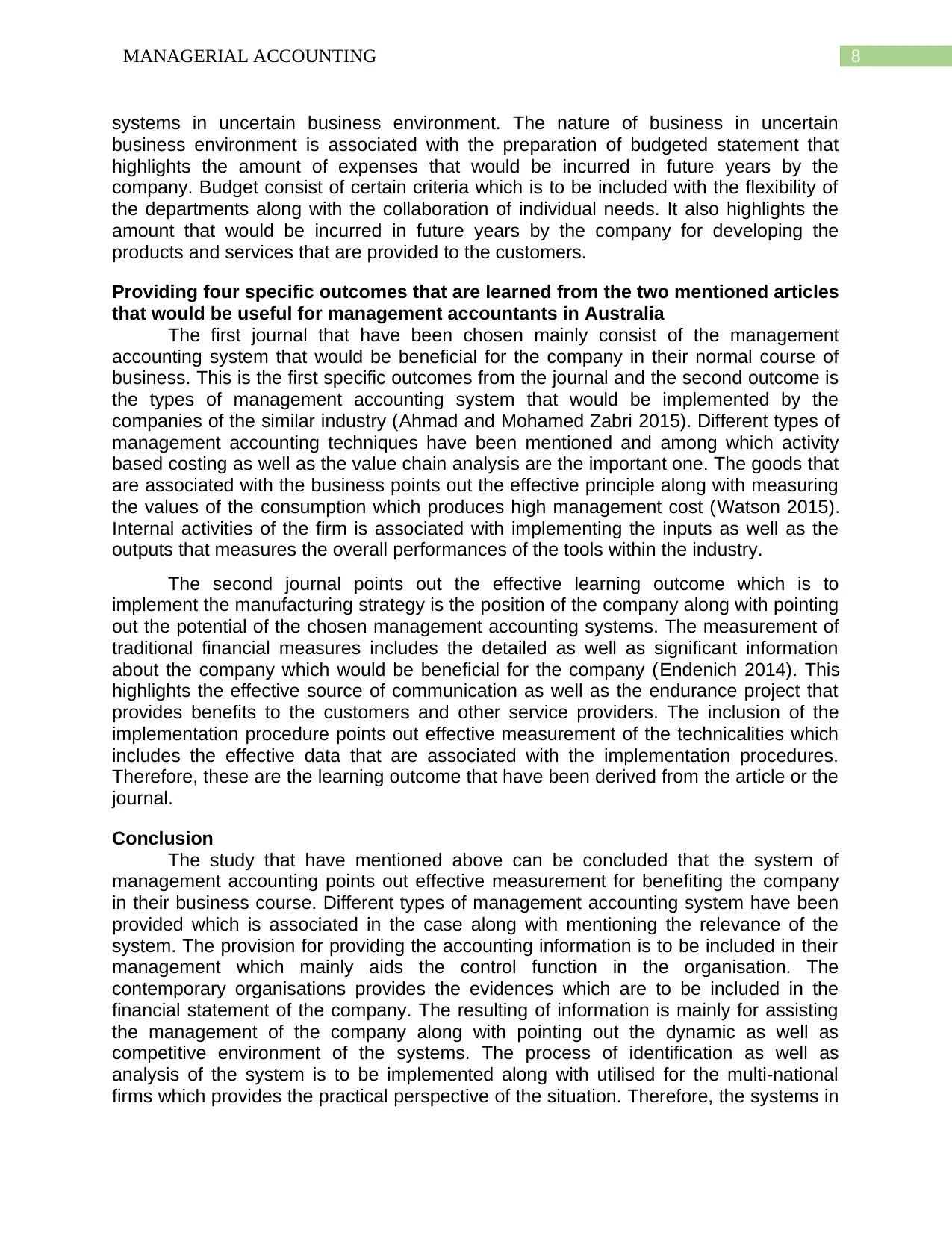
8MANAGERIAL ACCOUNTING
systems in uncertain business environment. The nature of business in uncertain
business environment is associated with the preparation of budgeted statement that
highlights the amount of expenses that would be incurred in future years by the
company. Budget consist of certain criteria which is to be included with the flexibility of
the departments along with the collaboration of individual needs. It also highlights the
amount that would be incurred in future years by the company for developing the
products and services that are provided to the customers.
Providing four specific outcomes that are learned from the two mentioned articles
that would be useful for management accountants in Australia
The first journal that have been chosen mainly consist of the management
accounting system that would be beneficial for the company in their normal course of
business. This is the first specific outcomes from the journal and the second outcome is
the types of management accounting system that would be implemented by the
companies of the similar industry (Ahmad and Mohamed Zabri 2015). Different types of
management accounting techniques have been mentioned and among which activity
based costing as well as the value chain analysis are the important one. The goods that
are associated with the business points out the effective principle along with measuring
the values of the consumption which produces high management cost (Watson 2015).
Internal activities of the firm is associated with implementing the inputs as well as the
outputs that measures the overall performances of the tools within the industry.
The second journal points out the effective learning outcome which is to
implement the manufacturing strategy is the position of the company along with pointing
out the potential of the chosen management accounting systems. The measurement of
traditional financial measures includes the detailed as well as significant information
about the company which would be beneficial for the company (Endenich 2014). This
highlights the effective source of communication as well as the endurance project that
provides benefits to the customers and other service providers. The inclusion of the
implementation procedure points out effective measurement of the technicalities which
includes the effective data that are associated with the implementation procedures.
Therefore, these are the learning outcome that have been derived from the article or the
journal.
Conclusion
The study that have mentioned above can be concluded that the system of
management accounting points out effective measurement for benefiting the company
in their business course. Different types of management accounting system have been
provided which is associated in the case along with mentioning the relevance of the
system. The provision for providing the accounting information is to be included in their
management which mainly aids the control function in the organisation. The
contemporary organisations provides the evidences which are to be included in the
financial statement of the company. The resulting of information is mainly for assisting
the management of the company along with pointing out the dynamic as well as
competitive environment of the systems. The process of identification as well as
analysis of the system is to be implemented along with utilised for the multi-national
firms which provides the practical perspective of the situation. Therefore, the systems in
systems in uncertain business environment. The nature of business in uncertain
business environment is associated with the preparation of budgeted statement that
highlights the amount of expenses that would be incurred in future years by the
company. Budget consist of certain criteria which is to be included with the flexibility of
the departments along with the collaboration of individual needs. It also highlights the
amount that would be incurred in future years by the company for developing the
products and services that are provided to the customers.
Providing four specific outcomes that are learned from the two mentioned articles
that would be useful for management accountants in Australia
The first journal that have been chosen mainly consist of the management
accounting system that would be beneficial for the company in their normal course of
business. This is the first specific outcomes from the journal and the second outcome is
the types of management accounting system that would be implemented by the
companies of the similar industry (Ahmad and Mohamed Zabri 2015). Different types of
management accounting techniques have been mentioned and among which activity
based costing as well as the value chain analysis are the important one. The goods that
are associated with the business points out the effective principle along with measuring
the values of the consumption which produces high management cost (Watson 2015).
Internal activities of the firm is associated with implementing the inputs as well as the
outputs that measures the overall performances of the tools within the industry.
The second journal points out the effective learning outcome which is to
implement the manufacturing strategy is the position of the company along with pointing
out the potential of the chosen management accounting systems. The measurement of
traditional financial measures includes the detailed as well as significant information
about the company which would be beneficial for the company (Endenich 2014). This
highlights the effective source of communication as well as the endurance project that
provides benefits to the customers and other service providers. The inclusion of the
implementation procedure points out effective measurement of the technicalities which
includes the effective data that are associated with the implementation procedures.
Therefore, these are the learning outcome that have been derived from the article or the
journal.
Conclusion
The study that have mentioned above can be concluded that the system of
management accounting points out effective measurement for benefiting the company
in their business course. Different types of management accounting system have been
provided which is associated in the case along with mentioning the relevance of the
system. The provision for providing the accounting information is to be included in their
management which mainly aids the control function in the organisation. The
contemporary organisations provides the evidences which are to be included in the
financial statement of the company. The resulting of information is mainly for assisting
the management of the company along with pointing out the dynamic as well as
competitive environment of the systems. The process of identification as well as
analysis of the system is to be implemented along with utilised for the multi-national
firms which provides the practical perspective of the situation. Therefore, the systems in
⊘ This is a preview!⊘
Do you want full access?
Subscribe today to unlock all pages.

Trusted by 1+ million students worldwide
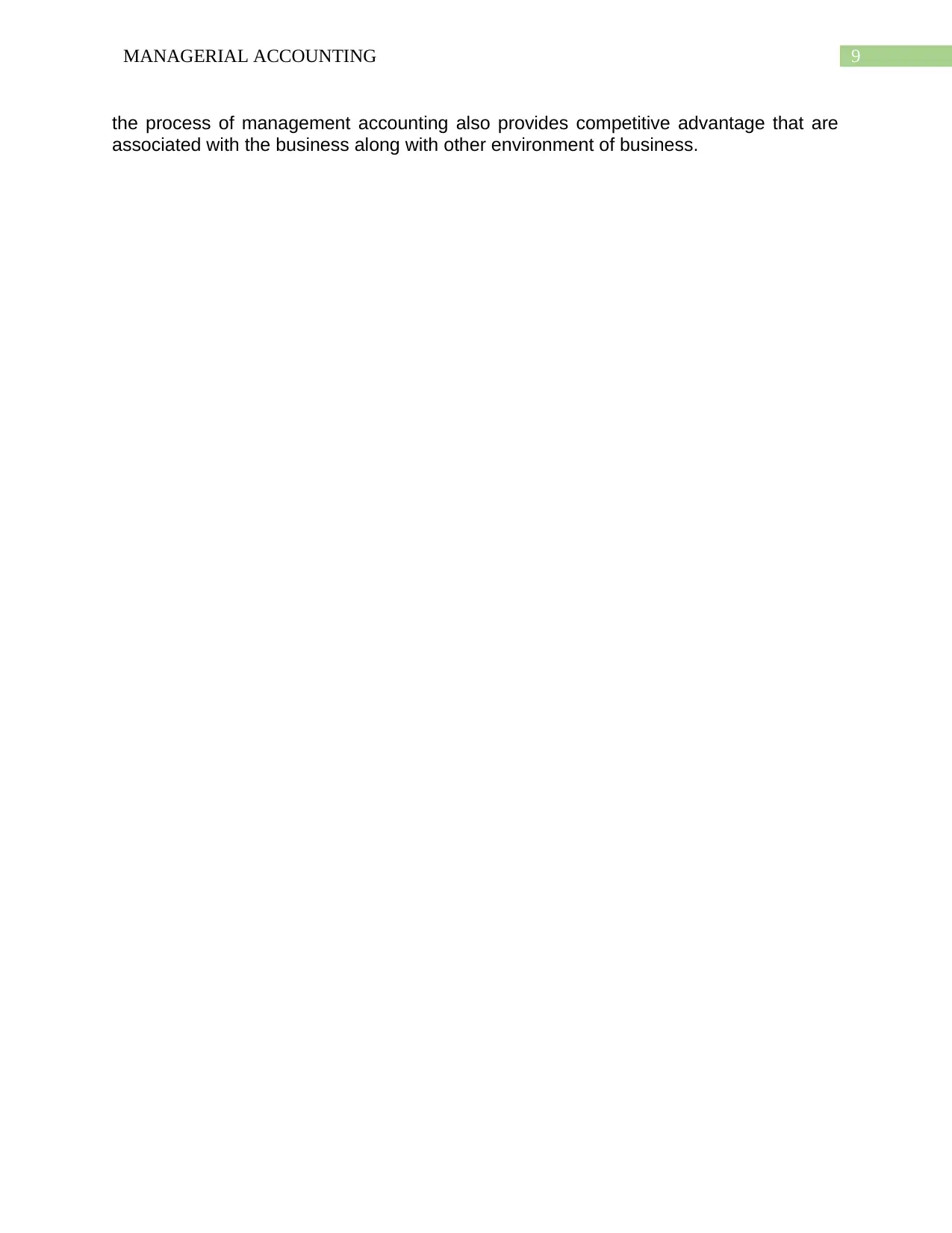
9MANAGERIAL ACCOUNTING
the process of management accounting also provides competitive advantage that are
associated with the business along with other environment of business.
the process of management accounting also provides competitive advantage that are
associated with the business along with other environment of business.
Paraphrase This Document
Need a fresh take? Get an instant paraphrase of this document with our AI Paraphraser
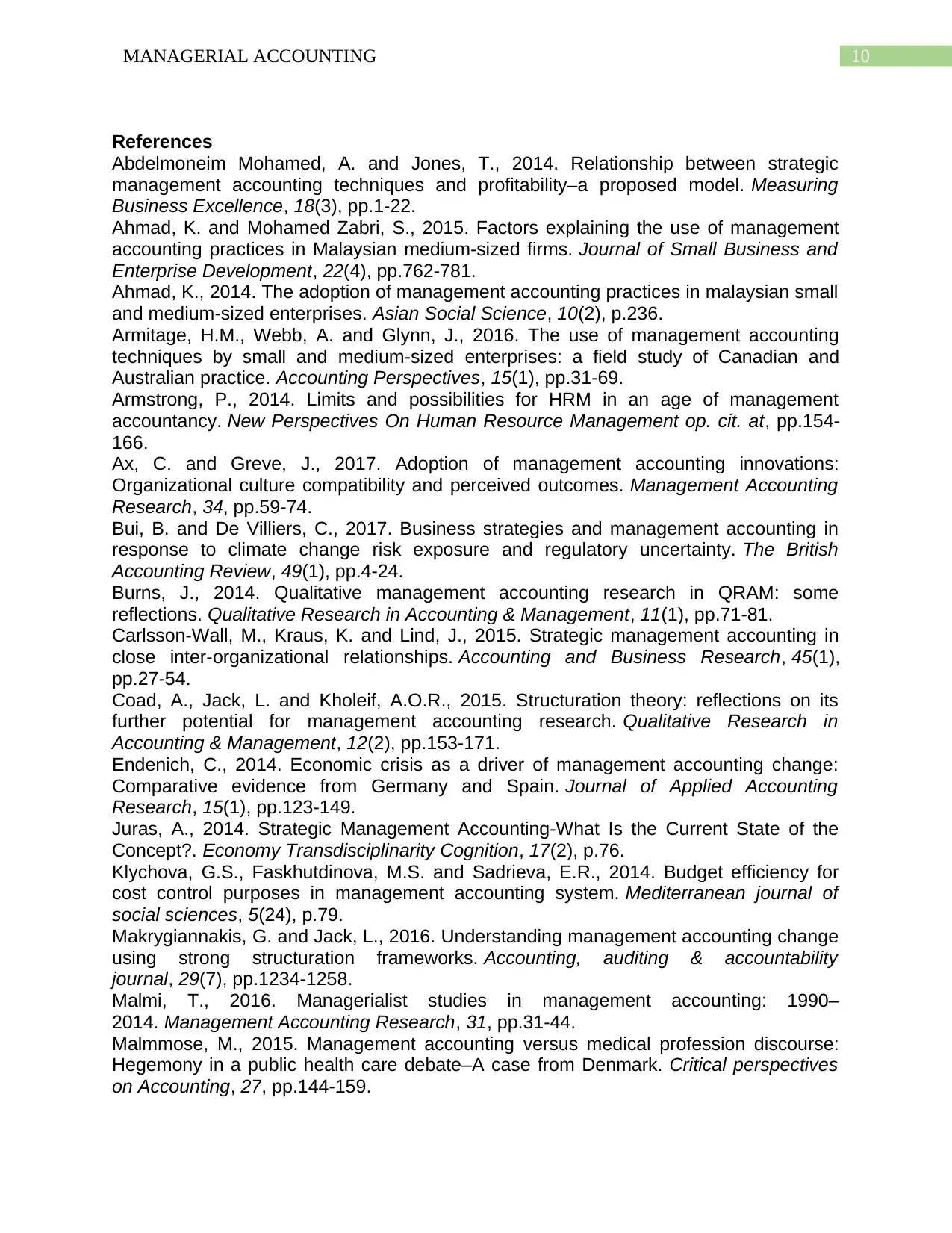
10MANAGERIAL ACCOUNTING
References
Abdelmoneim Mohamed, A. and Jones, T., 2014. Relationship between strategic
management accounting techniques and profitability–a proposed model. Measuring
Business Excellence, 18(3), pp.1-22.
Ahmad, K. and Mohamed Zabri, S., 2015. Factors explaining the use of management
accounting practices in Malaysian medium-sized firms. Journal of Small Business and
Enterprise Development, 22(4), pp.762-781.
Ahmad, K., 2014. The adoption of management accounting practices in malaysian small
and medium-sized enterprises. Asian Social Science, 10(2), p.236.
Armitage, H.M., Webb, A. and Glynn, J., 2016. The use of management accounting
techniques by small and medium-sized enterprises: a field study of Canadian and
Australian practice. Accounting Perspectives, 15(1), pp.31-69.
Armstrong, P., 2014. Limits and possibilities for HRM in an age of management
accountancy. New Perspectives On Human Resource Management op. cit. at, pp.154-
166.
Ax, C. and Greve, J., 2017. Adoption of management accounting innovations:
Organizational culture compatibility and perceived outcomes. Management Accounting
Research, 34, pp.59-74.
Bui, B. and De Villiers, C., 2017. Business strategies and management accounting in
response to climate change risk exposure and regulatory uncertainty. The British
Accounting Review, 49(1), pp.4-24.
Burns, J., 2014. Qualitative management accounting research in QRAM: some
reflections. Qualitative Research in Accounting & Management, 11(1), pp.71-81.
Carlsson-Wall, M., Kraus, K. and Lind, J., 2015. Strategic management accounting in
close inter-organizational relationships. Accounting and Business Research, 45(1),
pp.27-54.
Coad, A., Jack, L. and Kholeif, A.O.R., 2015. Structuration theory: reflections on its
further potential for management accounting research. Qualitative Research in
Accounting & Management, 12(2), pp.153-171.
Endenich, C., 2014. Economic crisis as a driver of management accounting change:
Comparative evidence from Germany and Spain. Journal of Applied Accounting
Research, 15(1), pp.123-149.
Juras, A., 2014. Strategic Management Accounting-What Is the Current State of the
Concept?. Economy Transdisciplinarity Cognition, 17(2), p.76.
Klychova, G.S., Faskhutdinova, М.S. and Sadrieva, E.R., 2014. Budget efficiency for
cost control purposes in management accounting system. Mediterranean journal of
social sciences, 5(24), p.79.
Makrygiannakis, G. and Jack, L., 2016. Understanding management accounting change
using strong structuration frameworks. Accounting, auditing & accountability
journal, 29(7), pp.1234-1258.
Malmi, T., 2016. Managerialist studies in management accounting: 1990–
2014. Management Accounting Research, 31, pp.31-44.
Malmmose, M., 2015. Management accounting versus medical profession discourse:
Hegemony in a public health care debate–A case from Denmark. Critical perspectives
on Accounting, 27, pp.144-159.
References
Abdelmoneim Mohamed, A. and Jones, T., 2014. Relationship between strategic
management accounting techniques and profitability–a proposed model. Measuring
Business Excellence, 18(3), pp.1-22.
Ahmad, K. and Mohamed Zabri, S., 2015. Factors explaining the use of management
accounting practices in Malaysian medium-sized firms. Journal of Small Business and
Enterprise Development, 22(4), pp.762-781.
Ahmad, K., 2014. The adoption of management accounting practices in malaysian small
and medium-sized enterprises. Asian Social Science, 10(2), p.236.
Armitage, H.M., Webb, A. and Glynn, J., 2016. The use of management accounting
techniques by small and medium-sized enterprises: a field study of Canadian and
Australian practice. Accounting Perspectives, 15(1), pp.31-69.
Armstrong, P., 2014. Limits and possibilities for HRM in an age of management
accountancy. New Perspectives On Human Resource Management op. cit. at, pp.154-
166.
Ax, C. and Greve, J., 2017. Adoption of management accounting innovations:
Organizational culture compatibility and perceived outcomes. Management Accounting
Research, 34, pp.59-74.
Bui, B. and De Villiers, C., 2017. Business strategies and management accounting in
response to climate change risk exposure and regulatory uncertainty. The British
Accounting Review, 49(1), pp.4-24.
Burns, J., 2014. Qualitative management accounting research in QRAM: some
reflections. Qualitative Research in Accounting & Management, 11(1), pp.71-81.
Carlsson-Wall, M., Kraus, K. and Lind, J., 2015. Strategic management accounting in
close inter-organizational relationships. Accounting and Business Research, 45(1),
pp.27-54.
Coad, A., Jack, L. and Kholeif, A.O.R., 2015. Structuration theory: reflections on its
further potential for management accounting research. Qualitative Research in
Accounting & Management, 12(2), pp.153-171.
Endenich, C., 2014. Economic crisis as a driver of management accounting change:
Comparative evidence from Germany and Spain. Journal of Applied Accounting
Research, 15(1), pp.123-149.
Juras, A., 2014. Strategic Management Accounting-What Is the Current State of the
Concept?. Economy Transdisciplinarity Cognition, 17(2), p.76.
Klychova, G.S., Faskhutdinova, М.S. and Sadrieva, E.R., 2014. Budget efficiency for
cost control purposes in management accounting system. Mediterranean journal of
social sciences, 5(24), p.79.
Makrygiannakis, G. and Jack, L., 2016. Understanding management accounting change
using strong structuration frameworks. Accounting, auditing & accountability
journal, 29(7), pp.1234-1258.
Malmi, T., 2016. Managerialist studies in management accounting: 1990–
2014. Management Accounting Research, 31, pp.31-44.
Malmmose, M., 2015. Management accounting versus medical profession discourse:
Hegemony in a public health care debate–A case from Denmark. Critical perspectives
on Accounting, 27, pp.144-159.
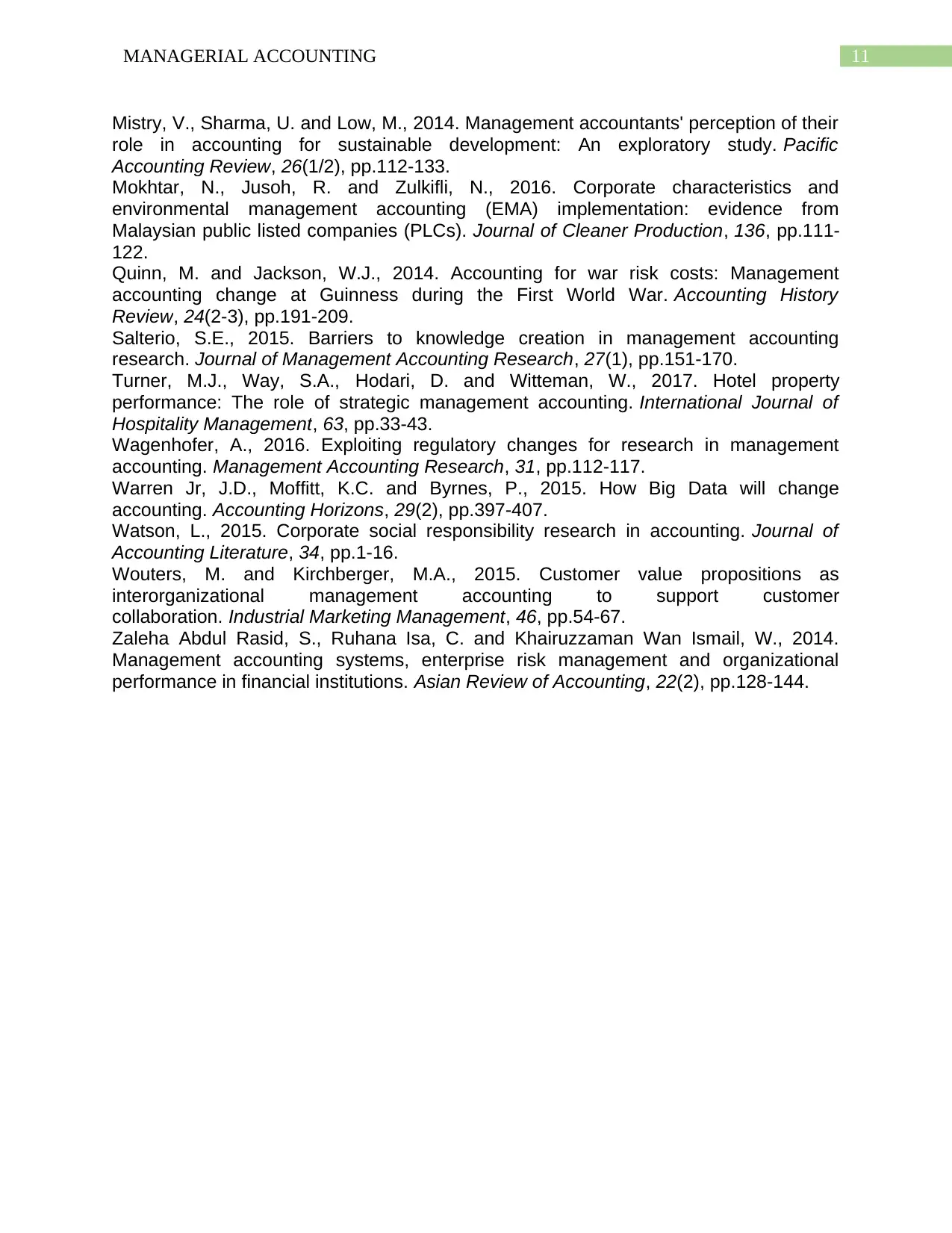
11MANAGERIAL ACCOUNTING
Mistry, V., Sharma, U. and Low, M., 2014. Management accountants' perception of their
role in accounting for sustainable development: An exploratory study. Pacific
Accounting Review, 26(1/2), pp.112-133.
Mokhtar, N., Jusoh, R. and Zulkifli, N., 2016. Corporate characteristics and
environmental management accounting (EMA) implementation: evidence from
Malaysian public listed companies (PLCs). Journal of Cleaner Production, 136, pp.111-
122.
Quinn, M. and Jackson, W.J., 2014. Accounting for war risk costs: Management
accounting change at Guinness during the First World War. Accounting History
Review, 24(2-3), pp.191-209.
Salterio, S.E., 2015. Barriers to knowledge creation in management accounting
research. Journal of Management Accounting Research, 27(1), pp.151-170.
Turner, M.J., Way, S.A., Hodari, D. and Witteman, W., 2017. Hotel property
performance: The role of strategic management accounting. International Journal of
Hospitality Management, 63, pp.33-43.
Wagenhofer, A., 2016. Exploiting regulatory changes for research in management
accounting. Management Accounting Research, 31, pp.112-117.
Warren Jr, J.D., Moffitt, K.C. and Byrnes, P., 2015. How Big Data will change
accounting. Accounting Horizons, 29(2), pp.397-407.
Watson, L., 2015. Corporate social responsibility research in accounting. Journal of
Accounting Literature, 34, pp.1-16.
Wouters, M. and Kirchberger, M.A., 2015. Customer value propositions as
interorganizational management accounting to support customer
collaboration. Industrial Marketing Management, 46, pp.54-67.
Zaleha Abdul Rasid, S., Ruhana Isa, C. and Khairuzzaman Wan Ismail, W., 2014.
Management accounting systems, enterprise risk management and organizational
performance in financial institutions. Asian Review of Accounting, 22(2), pp.128-144.
Mistry, V., Sharma, U. and Low, M., 2014. Management accountants' perception of their
role in accounting for sustainable development: An exploratory study. Pacific
Accounting Review, 26(1/2), pp.112-133.
Mokhtar, N., Jusoh, R. and Zulkifli, N., 2016. Corporate characteristics and
environmental management accounting (EMA) implementation: evidence from
Malaysian public listed companies (PLCs). Journal of Cleaner Production, 136, pp.111-
122.
Quinn, M. and Jackson, W.J., 2014. Accounting for war risk costs: Management
accounting change at Guinness during the First World War. Accounting History
Review, 24(2-3), pp.191-209.
Salterio, S.E., 2015. Barriers to knowledge creation in management accounting
research. Journal of Management Accounting Research, 27(1), pp.151-170.
Turner, M.J., Way, S.A., Hodari, D. and Witteman, W., 2017. Hotel property
performance: The role of strategic management accounting. International Journal of
Hospitality Management, 63, pp.33-43.
Wagenhofer, A., 2016. Exploiting regulatory changes for research in management
accounting. Management Accounting Research, 31, pp.112-117.
Warren Jr, J.D., Moffitt, K.C. and Byrnes, P., 2015. How Big Data will change
accounting. Accounting Horizons, 29(2), pp.397-407.
Watson, L., 2015. Corporate social responsibility research in accounting. Journal of
Accounting Literature, 34, pp.1-16.
Wouters, M. and Kirchberger, M.A., 2015. Customer value propositions as
interorganizational management accounting to support customer
collaboration. Industrial Marketing Management, 46, pp.54-67.
Zaleha Abdul Rasid, S., Ruhana Isa, C. and Khairuzzaman Wan Ismail, W., 2014.
Management accounting systems, enterprise risk management and organizational
performance in financial institutions. Asian Review of Accounting, 22(2), pp.128-144.
⊘ This is a preview!⊘
Do you want full access?
Subscribe today to unlock all pages.

Trusted by 1+ million students worldwide
1 out of 12
Related Documents
Your All-in-One AI-Powered Toolkit for Academic Success.
+13062052269
info@desklib.com
Available 24*7 on WhatsApp / Email
![[object Object]](/_next/static/media/star-bottom.7253800d.svg)
Unlock your academic potential
Copyright © 2020–2025 A2Z Services. All Rights Reserved. Developed and managed by ZUCOL.





